MONDAY
APRIL 15 - 2013
WAYSIDES
NEWS
Washington
Road path
Jane Brook and I
continued our regular Monday morning survey of the
Emsworth waysides. Today we started at the Washington
Road path wayside where we cut back and bagged the
brambles that were encroaching onto the small
embankment outside Glenwood School. We filled two bags
with the cuttings and the site now looks much better
for it.
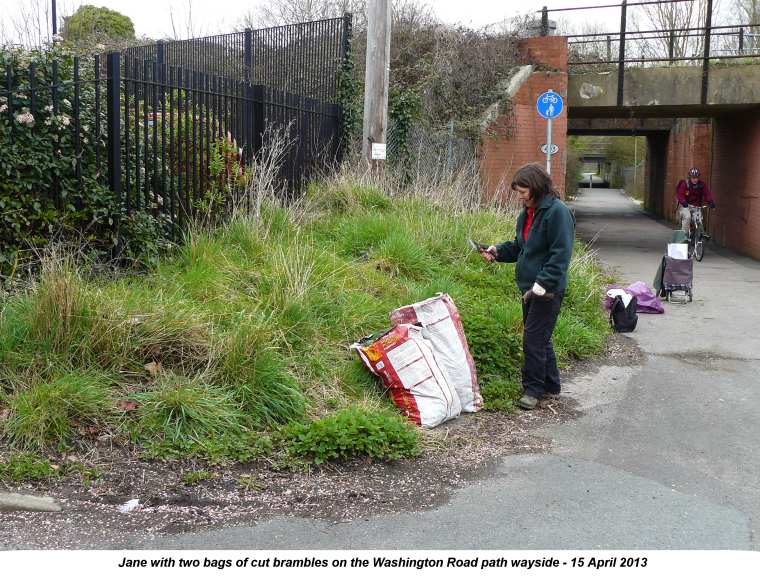
There are a lot more
bramble spurs overhanging the main path to the
Recreation Ground which I will inform Richard Denman
about. The clearance revealed a good flowering of
Lesser Celandines, plus some Common Field Speedwell
and Hairy Bittercress. Jane noticed an ant hill with
red ants on the embankment.
Railway
Wayside
The Coltsfoot
is still out with four flowers showing on the
embankment near the start of the ramp. We noticed the
first Hogweed flower of the year next to the
white lamp post near the start of the ramp. The
flowers were very pink. Two Bumblebees were seen, both
apparently asleep as was a 7-spot Ladybird.
The
queen Bumblebee in this photo has a pure white tail
and is probably Bombus lucorum
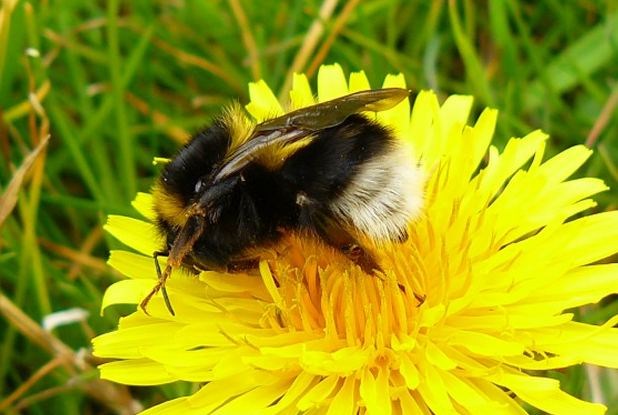
There
is a very good growth of Many-zoned Polypore
(Coriolus versicolor) on a fallen log.
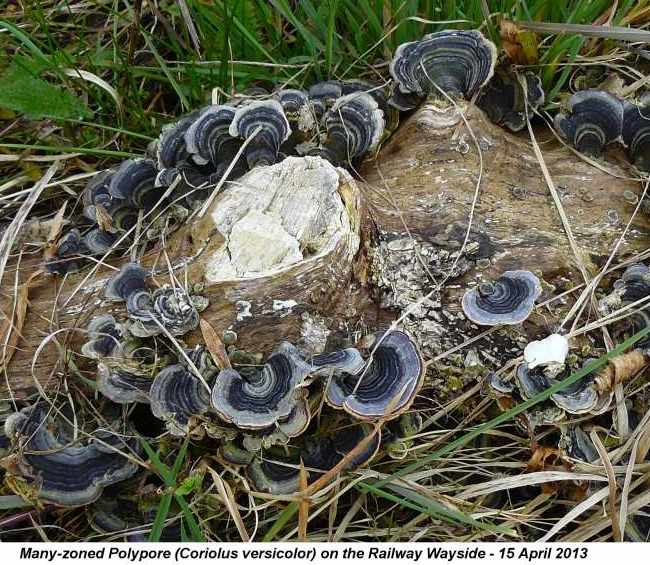
There is another
serious encroachment of brambles on this site, which
really needs a work party to clear, so Jane will have
a word with Andy about getting the Hollybank Woods
team down here.
MIGRANT
NEWS
Nightingales
at Thorney
Regarding the
Nightingale that Jean and I heard singing by the NRA
track across North Thorney yesterday, Thorney
Conservation warden Barry Collins replied that he had
two records of migrant Nightingales from this area in
the past, both singing males on 29th April 2005 and
14th April 2011. Barry says they used to breed at
Thorney Island (in the good old days) in the copse
near the TA Centre where we had 4 singing males from
1987 to 1992+ but sadly no more.
I checked the site
again this evening at 7.30pm, but there was no sound
of the Nightingale. However, I did hear a very close
(and loud) Cetti's Warbler from the same location and
the distant call of a Cuckoo from the eastern side.
Two warblers were actively feeding in a bush by the
track, which were probably Chiffchaffs thought I would
not rule out Willow Warbler with that sharp
supercilium - see photo below. This evening, I also
checked the classic Nightingale site at Marlpit Lane,
Woodmancote, but no luck there either.
My
best shot of the 'Willow-Chiff' at Thorney
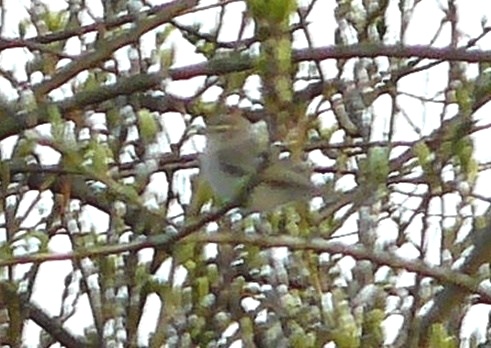
Barry Collins added
that he had his first singing Sedge Warbler and
a Whitethroat at the Thorney Little Deeps this
morning and a male Cuckoo calling near the hovel.
Terry Lifton also had her first Whitethroat of the
year during a walk along West Thorney from the marina,
along with a couple of House Martins and lots of
Swallows. Perhaps Spring is really here? See Ralph
Hollins Weekly summary for a full review of migrant
arrivals in the south . . . http://ralph-hollins.net/Summary.htm
Migrant
overlap
Peter Adeline wondered
if it was unusual for wintering birds to overlap with
summer migrants. This thought was prompted by his
seeing a flock of 150 Fieldfare on the Stansted Estate
last Friday (12th April) along with good numbers of
singing Chiffchaffs.
My feeling is that it
is not unusual, but this year there does seem to be a
reluctance in wintering birds to return to their
breeding grounds. Peter Milinets-Raby observed plenty
of wintering harbour birds during his walk along the
Warblington shore yesterday along with some summer
migrants. Peter commented specifically on the Pintail
which were lingering longer than he would expect them
to. These observations fit in with my theory that the
Blackcaps that have been seen in gardens over the last
couple of weeks are wintering birds feeding up for
journey 'home' and not newly arriving migrants. But
who knows? Ralph Hollins provides evidence for the
alternative theory that they are summer arrivals. See
. . . http://ralph-hollins.net/Summary.htm
Small
Tortoiseshell recovery
Ralph Hollins reports
16 sightings of Small Tortoiseshell this week
including one at Brook Meadow in Emsworth - at least
45 individuals have been seen since the first appeared
on Jan 1. Ralph concludes, "It certainly seems that
this butterfly is recovering from a severe crash in
numbers which started in 2003 and is thought to be
caused, at least in part, by a fly called Sturmia
Bella which lays its eggs in Small Tortoiseshell
caterpillars causing the death of the caterpillar as
the fly larva eats its innards".
SUNDAY
APRIL 14 - 2013
EMSWORTH
- THORNEY
Jean and I enjoyed a
gentle stroll down to Thorney Little Deeps this
morning. It really felt warm for the first time this
year! In Brook Meadow we happened to meet Richard
Daley and his mother. Richard has sent me very good
photos of Water Voles in the past and I encouraged him
to carry on. We did not get any sightings today.
Lungwort
Walking along the
causeway through Brook Meadow we spotted a Lungwort
plant in flower near the Alder Buckthorn plantation.
This is the first Lungwort I have seen in this
particular location, the only previous ones on Brook
Meadow were along the Lumley Path.

New Atlas on
Lungwort - A perennial herb, naturalised in
woodlands and scrub, on banks and rough ground, and
also occurring on rubbish tips and waste ground.
Neophyte (change +1.77). This species was cultivated
in Britain before 1597, and is now commonly grown in
gardens. Though some occurrences were treated as
possibly native in the 1962 Atlas, it is now regarded
as an introduction at all its British sites; it was
recorded from the wild by 1793. The number of records
has increased since the 1962 Atlas, particularly in
southern England, reflecting both increased abundance
and more intensive recording of aliens. A European
Temperate species, absent as a native from much of W.
Europe.
Great
Black-backed Gulls
Passing Slipper
Millpond Jean and I noted the presence of the pair of
Great Black-backed Gulls on the centre raft on Slipper
Millpond, one standing and the other sitting, but not
obviously on a nest. On our way back from Thorney we
happened to catch the gulls in the act of mating. This
is the first time I have seen this dramatic event with
these large birds.

Roger and Linda Mills
also saw the two gulls mating last Thursday (April 11)
on the north raft. So, they are clearly enjoying
themselves!
For
all the news on the Great Black-backed Gulls nesting
go to special page at .
. . Great
Black-backed Gull nesting
Thorney
Island
Jean and I walked down
the Wickor Bank to Little Deeps hoping for some
migrants, but the reedbeds were silent except for the
loud song of a Cetti's Warbler and a distant Reed
Bunting. There was no Reed Warbler or Sedge Warbler or
the Cuckoo that Barry Collins had reported earlier in
the week. However, we did enjoy seeing a good display
of Coltsfoot flowering on the bank in front of
the Little Deeps.

Nightingale
Our luck changed quite
dramatically as we made our way along the old 'NRA'
track towards Thornham Lane. We stopped about half way
along the track to listen to the wonderful song of a
Nightingale from the bushes to the south of the track
west of the overhead cables at Grid Ref: SU 755050.
This was the first Nightingale I personally have ever
heard in this area. Following the report of 5
Nightingales at Pulborough Brooks it seems that these
birds are bucking the trend of a slow return of
migrants.
A Swallow flew
overhead while we were listening to the Nightingale.
OTHER
SPRING NEWS
On opening my back
door this morning I was greeted with the mellifluous
song of a Blackcap. Is this a late wintering
bird or a migrant? Who knows? A little later a male
Brimstone flew through the garden, my first of
the year, but very much later than usual.
Tony Wootton reports
that today's walk just north of Midhurst produced 3
Swallows, an easy 6 Brimstones, Wood Anemones, a
single Wood Sorrel and Golden Saxifrage.
A Whitethroat
was seen on Farlington Marshes by P A Gammage in the
bushes near the deeps. Also 8 Swallows, 13 Sand
Martins, 3 Chiffchaff, 6 Willow Warbler and 2
Blackcap.
WARBLINGTON
NEWS
Peter Milinets-Raby
had more evidence of the arrival of spring during his
walk along the Warblington shore this morning from
6:35am to 9:15am taking in Warblington Farm, Conigar
Point and Langstone. It was a very low tide, with
expanses of mud and little in the way of waders. No
photos taken, everything was too distant. The
highlights were as follows:
Ibis Field:
Green Woodpecker, Pheasant, 2 Chiffchaff (plus 2
others singing), 2 Willow Warbler (plus one other
singing), Blackcap singing, 4 Med Gulls over. The
single Curlew was back along with 3
Moorhens
Conigar Point:
Little Egret, 2 Skylark (plus one other singing),
Greenshank - Coloured ringed RW on left, BtagY on
right, 3 Whimbrel dropped in onto the mud and fed for
20 minutes before heading off east, 6 Pintail (these
birds are lingering longer than I would expect them
to), 3 Grey Plover, 6 Med Gulls, 13 Shelduck, Reed
Bunting (Heard), Cormorant
Pook Lane: 2
Little Egret, 2 Knot (winter plumage - these birds are
really lingering), 6 Black-tailed Godwits (summer), 3
Grey Plover, pair of Red Breasted Merganser, 12 Med
Gulls feeding in the field next to the cemetery (11
adults and a smart looking first summer), Greenshank 1
(later 3 birds seen flying around calling, two left
north). 15 Shelduck, 16+ Teal, 9 Golden Plover
(summer), 27 Whimbrel (lovely calling flock flew over
heading east), 6 Dunlin (summer birds).
Langstone Mill
Pond/Shore: 1 Wheatear along sea wall. 12+ Teal on
tidal mud, 4 to 12 Swallows heading north, 1 Sandwich
Tern (summer bird), 15 Teal in horse paddock next to
pond, pair of Gadwall & 11 Moorhen in paddock,
Willow Warbler at the back of the paddock, Blackcap
male at the back of the paddock, 3 Grey Heron roosting
on the pond, Reed Bunting male, No Little
Egrets!!!
EDUCATION
AND THE NATURAL ENVIRONMENT
I was not aware until
I got a message from Ray Cobbett that Michael Gove is
planning to downgrade teaching on the natural
environment and climate change in the national
curriculum. Ray forwarded a couple of interesting
links:
A letter from David
Attenborough and many others requesting a change of
policy
http://www.tonyjuniper.com/content/letter-michael-gove-sunday-times-14th-april-2013
and a letter and
petition from a youngster
http://www.guardian.co.uk/environment/blog/2013/mar/19/geography-climate-change-unjust
SATURDAY
APRIL 13 - 2013
Mute
Swan walkabout
Malcolm Phillips went
out in the rain this morning and came across this Mute
Swan, presumably one of the Peter Pond pair, going
walk about along the Gooseberry Cottage drive. Malcolm
is off to Cuba, so this is his last photo for two
weeks.

Sparrowhawk
in garden
Tony Wootton has his
daughter Gayle to thank for spotting a Sparrowhawk in
his garden this morning. Tony captured this superb
series of photos as the bird flew on to a neighbour's
garage roof where it proceeded to cough up a ball of
undigested food and then it defecated before finally
flying off. Tony says, "Whilst I've seen them flying
over, this is the first time a Sparrowhawk has landed
in our garden. I presume it was a juvenile male
because of its rufous markings".
Here
is Tony's photo of this cracking juvenile male
Sparrowhawk
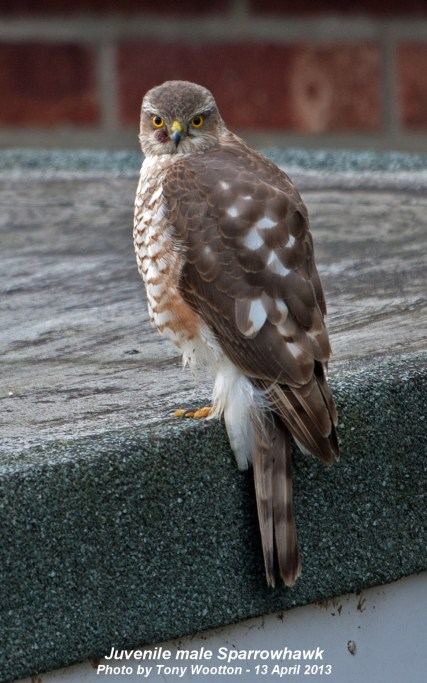
Sparrowhawks, like all
birds of prey, create a small parcel (called pellet)
of those parts of their prey, such as fur, bones and
feathers, which they they are not able to digest. They
regurgitate these and they may be found on the ground
near their eating place.
Tony's
photos of the bird coughing up and dropping a pellet
of undigested food
. . .
and its final act
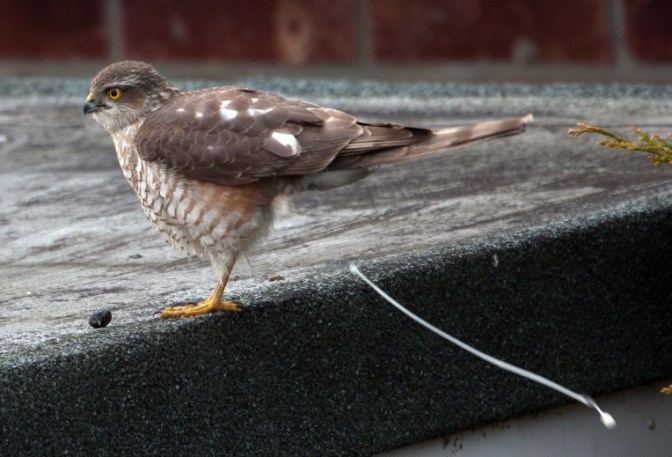
Garden
Blackcaps
I got taken to task by
Ralph Hollins for insisting in yesterday's blog that
the Blackcaps that I and others have been getting in
our gardens are wintering birds and not summer
migrants. Ralph rightly pointed out that they could be
hungry new arrivals seeking easy food after a long
flight. Point taken, though personally I prefer to
wait until I hear that rich fluty song in the
appropriate breeding habitat before accepting them as
definite migrants. For example, Bob Chapman had his
first Blackcap of the year at Farlington Marshes on
April 11 which he is sure was a migrant. See . . .
http://solentreserves.wordpress.com/
All this assumes the
winter and summer populations of Blackcaps really are
distinct and that no mixing goes on during the
overlap. Just a thought.
Interestingly, Malcolm
Le Grys comments (on SOS Sightings Apr 11) that he has
been recording wintering Blackcaps in his Keymer
garden since 1993 and has never seen an April influx
like this. He says, most normally leave well before
the end of March, but this year there has been an
unprecedented number of late arrivals. This suggests
to me a weather related delay in birds leaving for
their breeding grounds on the Continent, though Ralph
may wish to interpret it differently.
Migrant
arrivals
Meanwhile, definite
migrants are arriving at long last. Barry Collins had
both Cuckoo and Willow Warbler singing at the Little
Deeps on Thursday Apr 11. There was lots of migrant
activity at Pulborough Brooks RSPB Reserve this
morning, including three singing Nightingales and at
least five on the reserve. Also small parties of
Swallows and Sand Martins and at least one Willow
Warbler and a Blackcap. Maybe, we should start
checking out the Marlpit Lane bushes?
FRIDAY
APRIL 12 - 2013
GARDEN
Two
Blackcaps
There have been lots
of reports on Hoslist of Blackcaps in garden, all I am
sure wintering birds feeding up in preparation for
their journey back to the Continent. I too had two
males in my garden this morning, feeding actively in
the shrubs, though they did not come onto the feeders.
Here
are the two male Blackcaps on a Buddleja. The second
bird is partly hidden

House
Sparrows
I was almost as
pleased to see three House Sparrows on the bird table;
these are very scarce in the garden these days.
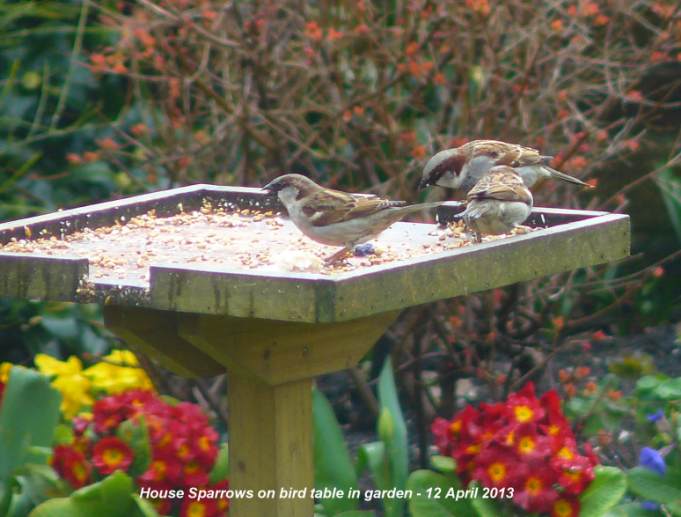
BROOK
MEADOW
Bird
song
Two Chiffchaffs
were singing on Brook Meadow, one on the north path
and the other near the Lumley gate. Malcolm Phillips
captured this rather fine photo of a Chiffchaff in
full voice, looking remarkably like a Whitethroat with
its throat feathers fluffed up.
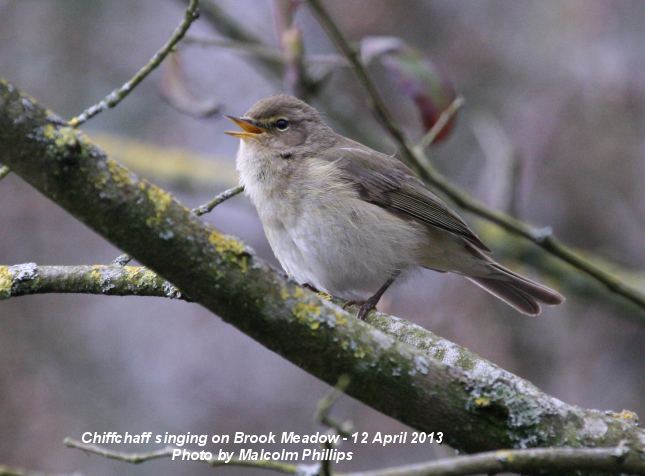
However, there was
no sound of a Blackcap. They could be up to two
weeks late. Here are the first song dates on Brook
Meadow over the past 4 years: Apr 2, 2009, Mar 30,
2010, Mar 28, 2011, Mar 26, 2012,
Possible
Water Shrew
Malcolm told me he had
seen a very small mammal in the river near the
north-east corner on another occasion, but did not get
a photo. This could have been a Water Shrew which we
have seen on occasions in the past. Maurice Lillie saw
what could have been one in the Palmer's Road Copse
river on 03-May-12. Patrick Murphy came across a
rather bedraggled creature on the main path on
30-Apr-08. Here is a Water Shrew swimming - not one of
our photos.

MILLPONDS
I was surprised to see
a Little Grebe fishing on Peter Pond; they are usually
on Slipper Millpond. A Coot is sitting on a nest on
the floating raft in the centre of the pond; they also
nested there last year and raised a brood.
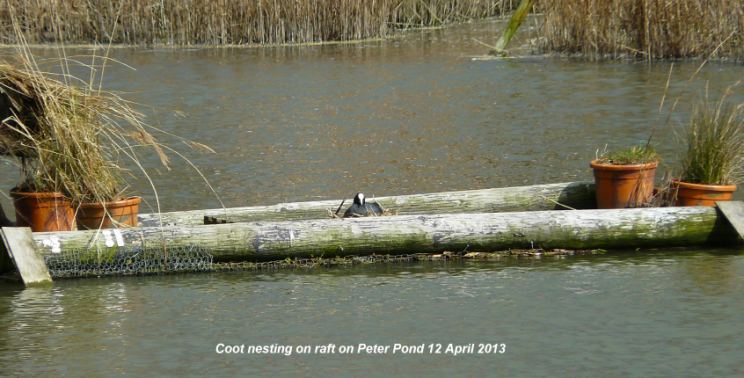
One Mute Swan was on
Peter Pond and the other on Slipper Millpond; no sign
of any nest building. Both Great Black-backed Gulls
were on the centre raft on Slipper Millpond with one
sitting and the other standing; I could not see any
nest. But, clearly they are back! A flock of around
100 Black-headed Gulls were on the pond with two
Mediterranean Gulls.
Here
are the two Great Black-backed Gulls on the raft with
two Mediterranean Gulls in background
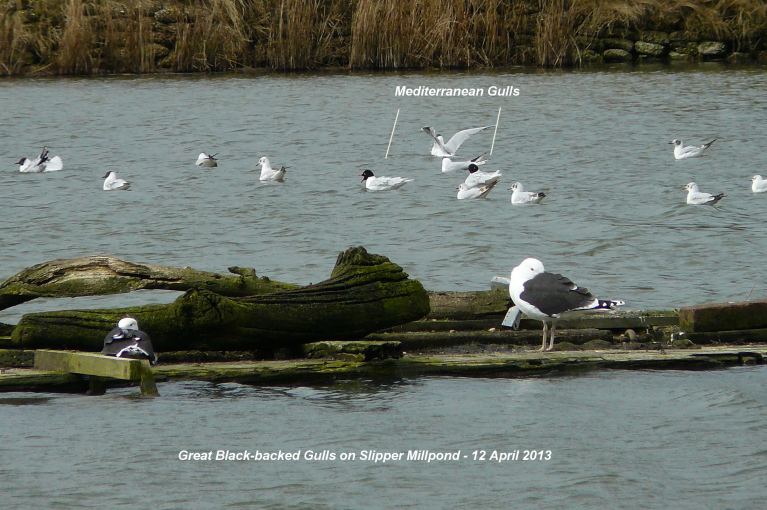
WAYSIDES
NEWS
Approaching the
Lillywhite's path wayside from the millponds, I
puzzled over the Mouse-ears on the eastern verge near
the 'Hampshire' road sign. The plant with a tight
cluster of flower buds at the top of the stem is
probably Sticky Mouse-ear. I think I also found Common
Mouse-ear along with Common Chickweed.
Sticky
Mouse-ear on the Lillywhite's path wayside

OTHER
NEWS
First
Swallow
Terry Lifton had her
first Swallow over the house yesterday, the latest she
has ever seen them.
PETER'S
WALK
Peter Milinets-Raby
walked from Warblington Church along the shore to
Langstone Mill Pond. The birds of note were as
follows:
Ibis Field on
Warblington Farm: Swallow, 3 Willow Warbler, Blackcap
male moving through bushes by stream, 2+ Chiffchaff
(one heard singing), 3 Little Egret, 2 Med Gull over,
3 Teal, 2 Stock Dove. No Ibis!
Pook Lane: 4 Grey
plover, 9 Black-tailed Godwit, 3 Pintail (male & 2
females), 27 Shelduck, 2 Swallow, Peregrine circling
around for two minutes before drifting off west, 36
Golden Plover (summer plumage), 2 Brent Geese, 12+
Teal, Red Breasted Merganser, 11 Bar-tailed Godwits.
Little
Egret at Langstone
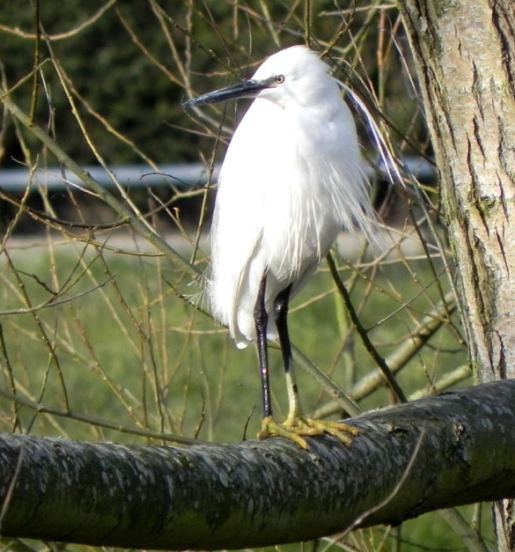
Langstone Mill
Pond/Shore: In flooded horse paddock north of Mill
Pond. A pair of Gadwall, 8 Teal (low tide, so not as
many as last visit), 5 Little Egret roosting, 14
Moorhen, Water Rail creeping about at the back, 4+
Willow Warbler at the back of the paddock by the
fence, Redstart (female) at the back of the paddock,
Blackcap male (back of paddock), 6 to 10 Med Gulls
over, Swallow, Sand Martin, Chiffchaff singing, Mute
Swan on nest on pond, Reed Bunting (male) - calling
again, not singing? 7 Little Egrets roosting on pond,
but no nest building activity (At least they were
present)
Off shore on the
Langstone Mill Creek: 77 Black-tailed Godwits, 2
Bar-tailed Godwits, 1 Knot
THURSDAY
APRIL 11 - 2013
EMSWORTH
Brook
Meadow
A Song Thrush was
singing strongly from the large Ash tree on the
railway embankment. This is probably the bird that
Malcolm Phillips photographed that is featured in 'The
Portsmouth News' this evening. There was plenty of
other bird song, but no sign of Blackcap.
Slipper
Millpond
I was surprised to
find no Great Black-backed Gulls on the pond this
morning. They were both present on the centre raft
yesterday, with one seemingly sitting on a nest.
Lillywhite's
wayside
Sea Buckthorn and
Blackthorn blossom is now opening on the wayside
behind Lillywhite's Garage.
Here
are some of the tiny flowers on the Blackthorn.

Sweet Violets
are still out, with three colour varieties on show,
normal dark violet, white and the 'intermediate' pink
of the same shade as those in Nore Barn Woods.

BTO
NEWS
Summer
migrants late
Migrants have
continued to trickle in but it has been slow and most
of our early arriving summer visitors are running two
to three weeks late. See for example, the BirdTrack
reporting rate graph for Chiffchaff at
http://bto-enews.org/IG4-1DDKQ-3RN36S-K4VXK-0/c.aspx
However, with a change in the weather, species such as
Whitethroat and Sedge Warbler have arrived on time.
Two more Cuckoos were reported this week, in East
Sussex and Kent, and our first satellite-tagged Cuckoo
could make his move from France to the UK any day now.
By Saturday we should be enjoying warm winds from the
south which will bring migrants with them.
Nesting
delayed
The cold start to the
breeding season has delayed nesting attempts this
year. Although birds have been prospecting sites as
usual, far fewer have started laying eggs and things
generally seem to be a fortnight behind
schedule.
WEDNESDAY
APRIL 10 - 2013
EMSWORTH
Nore
Barn
10:00 10:30 - Tide
rising to high water in about 2 hours.
There was nothing in
the stream when I arrived, nor in the pond at the top
of the creek. However, I did spot a Greenshank
snoozing on the edge of the channel in the creek. The
Common Redshank was in the stream when I got
back; this is the bird that Maggie previous thought
might have been a Spotted Redshank. But there is
really no doubt that the two Spotted Redshanks that
have been at Nore Barn have left.
I counted 20 Brent
Geese in the creek, including a family with 2
juveniles, possibly one of those that have been in the
Nore Barn area over the winter. I also counted 48 Teal
along with a few Wigeon.
I found a small patch
of Sweet Violets, with normal colouring, on the
southern path close to the wooden post marking the
start of the bridleway. I do not recall having seen
this patch before. I was hoping for Greater Stitchwort
but there was no sign of any, though Ralph Hollins has
found some in flower in Havant.
Slipper
Millpond
The Great
Black-backed Gulls were both on the centre raft
with one apparently sitting on a nest of twigs. This
is the first confirmed date of nesting. This is
earlier than last year when my first sighting of one
sitting was 27-Apr.
Here
is what I assume is the female sitting on a nest of
twigs

One Mute Swan
was on Slipper Millpond and the other on Peter
Pond, but no sign of nesting.
Coot pairs are now
nesting on both the northern and the southern
rafts. Fortunately, the nest box has been removed from
the centre raft so there will be no temptation for the
Coot to nest right next to the Great Black-backed
Gulls as happened last year.
This
is the Coot pair on the southern raft on Slipper
Millpond
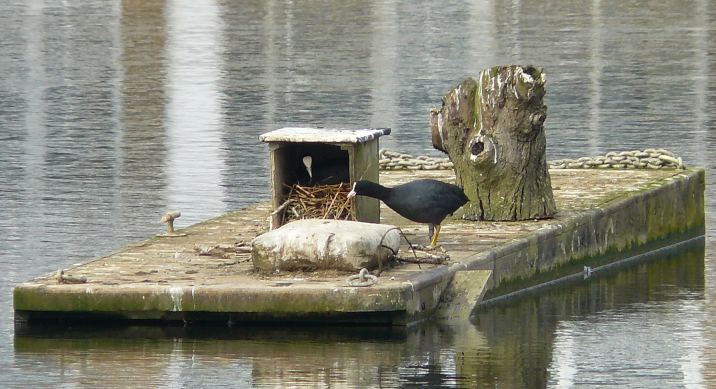
Red
Kite over Emsworth
Terry Lifton was
excited to see this Red Kite circling over and around
their garden this afternoon. Terry says,
"Not
the first Red Kite I've seen over Emsworth, but
certainly the closest".
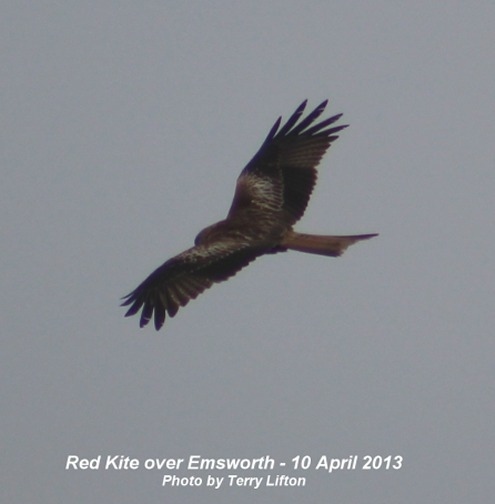
TUESDAY
APRIL 9 - 2013
Grey
Wagtail in garden
We had an unusual
visitor to the garden today in the form of a perky
Grey Wagtail. It perched briefly on the wall which
overlooks the Westbrook Stream at the end of the
garden before flying off not to be seen again. I do
occasionally see Grey Wagtail in the stream in Bridge
Road car park which is about 200 yards further down
the road from us, but I have only three previous
records of one in the garden: 03-Oct 2004. 06-Feb 2003
24-Dec 2001.
Brent
Geese on the move
Bob Chapman reported a
mass departure of birds on Saturday April 6, during
which 1500 Brent Geese left Langstone Harbour in the
evening along with lots of waders. Bob says this is a
month later than they would normally go and reflects
the influence of the prolonged cold easterly winds.
They will stop off in Holland to feed up before their
long onward flight to Siberia in six weeks or so. See
. . . http://solentreserves.wordpress.com/
I always thought that
Brent Geese moved round the coastline on their way
north. However, a flock of circa 45 Brent Geese were
reported flying over Pulborough Brooks RSPB Reserve
yesterday. Is this unusual?
Summer
migrants
In a response to a
query about Blackcap sightings, Glynne Evans on
Hoslist says they are most likely to be wintering
birds. BTO BirdTrack reporting rate suggests that
summer Blackcaps have not yet arrived. Also, in his
own garden, Glynne had seven wintering Blackcaps on
Sunday plus a ringed male that is almost certainly the
same bird that has been present all winter.
A small sign of summer
was a single Swallow and two House Martins seen flying
over the Pulborough Brooks reserve yesterday by Peter
Hughes. I have just seen the weather forecast and the
winds are turning warm and southerly at the weekend,
so that should bring the migrants flooding in.
Bats
flying in daytime
Ralph Hollins refers
us to the Portland Bird Observatory web site which has
a couple of bat photos above the Apr 6 entry that look
similar to that taken by Malcolm Phillips at Brook
Meadow on the same day. Martin Cade at Portland
supports Nik Knight's view that the bats are
Pipistrelles but he also makes the suggestion that the
reason for day flying is the shortage of insects to be
caught at night in this cold weather when the bats
will be especially hungry on emergence from
hibernation.
See . . . http://www.portlandbirdobs.org.uk/aa_latestnews.htm
Ring
Ouzel
Regarding Caroline
French's Ring Ouzel sighting, Ralph says Caroline need
not worry that her photo does not show the light patch
in the wing which usually only shows well in flight
when the feathers are stretched out. However, Ralph
does provide the following link to a Ring Ouzel photo
showing the silvery wing panel quite nicely . . .
http://www.devonbirds.org/images/cache/690f1454da5a8541fb0336c53edfcaed.jpg
MONDAY
APRIL 8 - 2013
Waysides
surveys
Jane Brook and I made
a start on our regular survey of the Emsworth waysides
this morning. We did the four sites in North Emsworth,
starting at Southleigh Road (west). We were very late
starting due to the poor weather, but we need not have
bothered as there was little in the way of wild
flowers to see. However, it was good to renew contact
with the waysides. The biggest change was in the
Spencer's Field verge where the council have done some
lopping and clearance of trees.

Brook
Meadow and Lumley
Malcolm Phillips went
round the meadow today. He had no Water Vole
sightings, but did see the Woodpecker in the Great Tit
nest hole. He then walked round to the Lumley stream
under the railway, where he got a nice photo of a
Woodpecker.
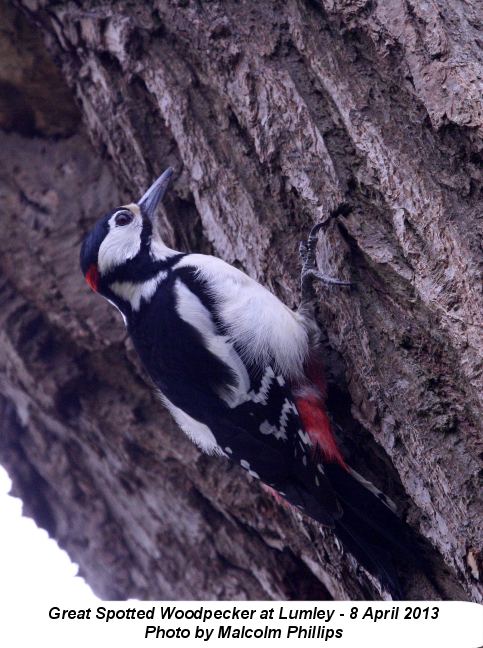
Malcolm carried on to
Peter Pond where he found a pair of Goldcrests and a
Chiffchaff. Back through the meadow just in time to
see the Buzzard take off from the trees in the middle
and fly north.
Ring
Ouzel at Stoughton
Caroline French
carried out her final BTO Winter Thrushes Survey at
her allocated 1km square at Stoughton. She reports,
"I
have been doing them monthly since November and, apart
from 4 Redwings and the odd Mistle Thrush and Song
Thrush, usually all I see in the way of thrushes are
Blackbirds. But today I was treated to a Ring Ouzel!
It was sitting high in a tree, with a Mistle Thrush
for company. I just about managed to digiscope it, but
as it was at least 200m away from me, the image is
poor."
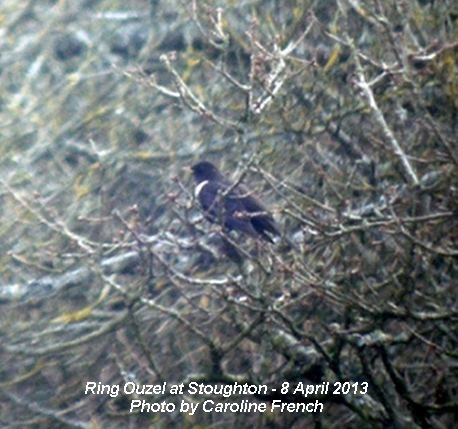
Caroline's only
reservation about identification is that it doesn't
show pale wings. In all other respects though it fits
the description of Ring Ouzel: white crescent across
the chest - very well defined; dark tip to bill; no
yellow eye ring that a male Blackbird would show. Grid
ref. SU801125 on the northern edge of Inholmes Wood,
just west of the footpath. Interestingly, this is the
third local Ring Ouzel in the past week, following
those on Thorney Island and Warblington Farm.
Personally, I have never seen one locally. Caroline
also saw Brown Hares around on the bare fields and
young crops and a few Skylarks that were
singing.
Robins
fighting
Caroline also watched
two Robins fighting, almost to the death it seemed.
"I
couldn't see very clearly because they were partly
obscured by grass but it looked like one bird had
managed to pin the other on the ground and was pecking
viciously at it. What seemed a bit incongruous (to my
ears) was that one of the birds was singing away the
whole time! I thought it was probably the one on top
asserting his dominance but maybe it could have been
the other one refusing to be beaten into submission!
Eventually they parted and one flew away, possibly
injured. "
Brent
Geese
Tom Bickerton has been
photographing the behaviour patterns of the Brent
Geese for some time, where they turn turtle in the
fresh water to clean the plumage. He got the following
image on Saturday at Farlington. He thinks it was
their final brush-up and go before the flight back
north, which a lot did in the evening on Saturday.
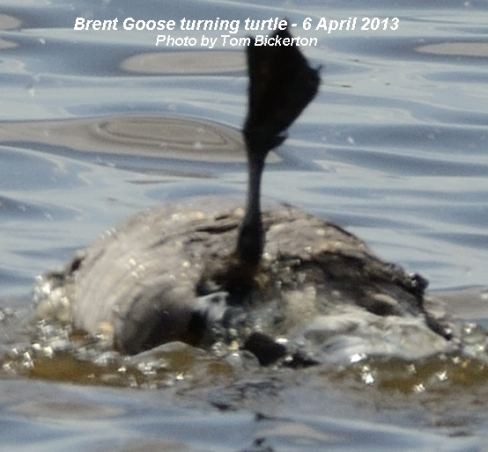
Tom also included the
following image of a pair of Brents, as a good example
of how to tell male and female apart; male on left,
female on right. Main clue is head shape, but the male
is bigger and bulkier.

Hawfinches
at Romsey
Tony Wootton went
twitching with Ros Norton to Romsey today and got
really good views of possibly 10 Hawfinches, lifetime
firsts for them both. Also on the same bit of woodland
close to a housing estate they heard a Blackcap
(probable migrant?) and saw 2 Chiffchaffs and a
Brambling. Tony concludes,
"Quite
an amazing little spot".
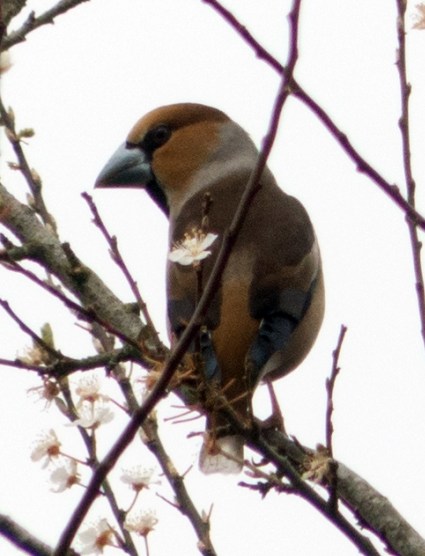
SUNDAY
APRIL 7 - 2013
BROOK
MEADOW
Conservation
work session
I went over to the
meadow this morning mainly to take photos of the
conservation work session. Twelve volunteers turned up
on a fine morning. The main jobs were clearing long
bramble spurs and removing the temporary barriers
around the wild flower area on the north meadow. A
full report and more photos will shortly be on the
Brook Meadow web site at . . . http://www.brook-meadow.hampshire.org.uk/bm-work_diary-2013.htm
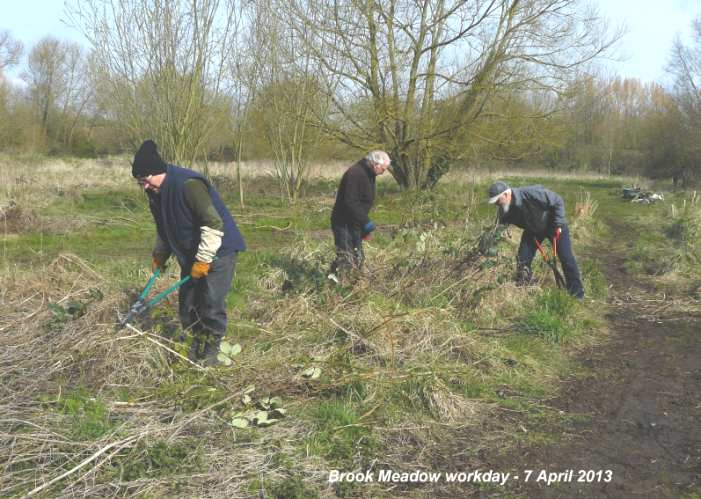
Birds
A Song Thrush was
singing strongly from the east side of the north
meadow. I heard two Chiffchaffs singing, one from
Lumley copse and the other from the Peter Pond copse;
they are almost certainly migrants. But I have still
to hear a Blackcap song; they are certainly very late
this spring. I could hear the mewing calls of a
Mediterranean Gull flying overhead.
Insects
I was hoping to see
butterflies after Malcolm's success yesterday, but I
did not see a single one.
Butterbur
count
I carried out the
annual count of Butterbur flower spikes in the four
main areas:
1. embankment on west
side of centre meadow = 264 (330)
2. River banks around the sluice gate = 50 (93)
3. West side of south meadow = 36 (24)
4. East end of causeway = 28 (99)
Total = 378 (546)
As can be seen the
counts in all areas were down except for the south
meadow which was slightly up on last year. The largest
fall was on the east causeway. The total count is well
down on the previous 4 years but more on a par with
the earlier counts as shown in the chart.
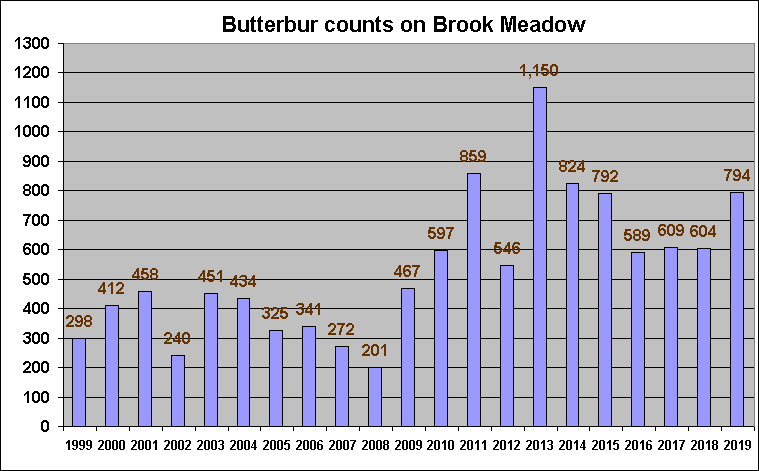
MILLPOND
NEWS
Mute
Swans
The dark legged Mute
Swan (male?) was on the east bank of Peter Pond by
Lumley Road. Its pink legged mate was on Slipper
Millpond. I have not seen them together for some time.
There is no sign of any nest building. I am not
optimistic.
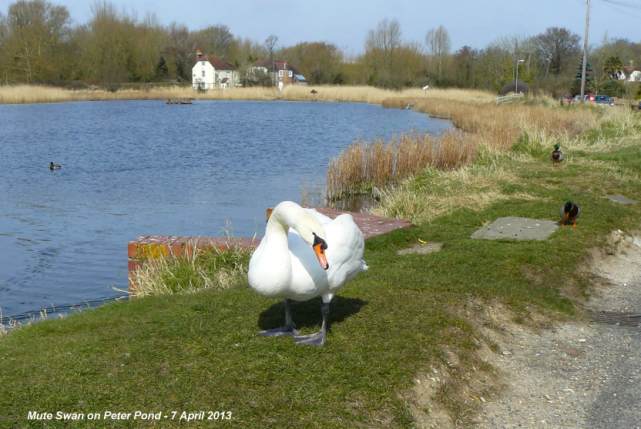
Coot
The Coots are well
established in the nest box on the northern raft on
Slipper Millpond. There was no sign of the Great
Black-backed Gulls.
Great
Crested Grebe
Francis Kinsella found
the Great Crested Grebe on the town millpond on both
Friday and Saturday and got a very nice photo of the
bird. Jean and I walked round the pond this afternoon,
but it was not there. I have yet to see the bird!
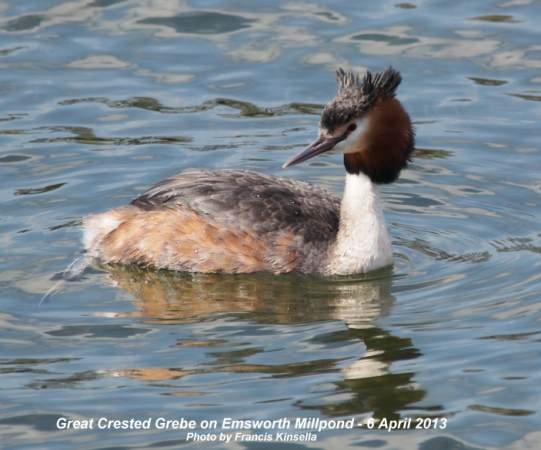
NORE
BARN
12:00 - 12:30 - About
2 hours after high water. Nothing in the stream. The
Greenshank was feeding in the pond at the top of the
creek, but there was no sign of the Spotted Redshank.
My guess is that the dark plumaged bird has also left
the area; my last sighting was on Apr 1. I counted 26
Brent Geese in the creek along with 14 Teal.
OTHER
NEWS
Kingfisher
on the Ems
Francis Kinsella saw a
Kingfisher close to the River Ems at Westbourne. He
only saw it fleetingly and from a distance - too far
away to get a decent photograph, but the shot he got
was good enough for identification. He also saw a
juvenile Sparrowhawk in the same area.
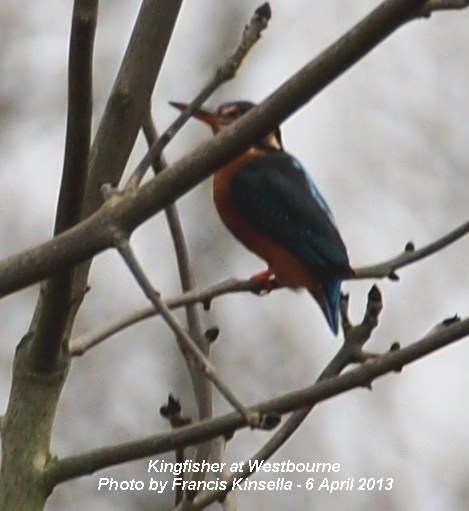
Ravens
at Horndean
Fiona McKinnon checked
on the Ravens again yesterday, watching the nest with
her scope. She was surprised that the adult was not
sitting on the nest but sitting beside it as although
the sun was shining it was cold. When the second adult
returned two possibly three gaping breaks popped up
begging to be feed. Fiona also saw 15 Wheatear in the
same field.
PETER'S WALK
Peter Milinets-Raby
could not resist doing his regular walk from Nore Barn
to Warblington and back this morning. For the first
time he took my telescope so he could count the waders
more accurately. He started at Nore Barn at 7am,
walked along the shore to Langstone Mill and then back
inland past the church and returned at 9:40am.
Peter's highlights
were as follows:
Nore Barn: A
single singing Chiffchaff in the wood, 2 Whimbrel over
heading north east 11 Grey Plover, 31 Brent Geese, 3+
Curlew, 60+ Teal, 42 Dunlin, 5 Wigeon, 1 Greenshank at
the top end near the pond field. Little Egret (only
one seen today), 1 Canada Goose.
Conigar Point:
2 Meadow Pipit over, 22 Grey Plover, 10 Pintail, 144
Dunlin (all in winter), 1 lonely Knot (winter
plumage), 2 Greenshank (one with coloured rings RW on
left, B(tag)Y on right), Skylark singing inland, 11
Bar tailed Godwit (all in winter), 1 Black-tailed
Godwit (summer), 7 Cormorant, 4 Red breasted
Merganser, 15 Turnstone, 35 Shelduck, 46+ Teal, 4
Wigeon, 5 Brent Geese.
Pook Lane: 2
Greenshank (one with coloured rings RG on left, YY on
right), 4 Med Gulls, 3 Black-tailed Godwit (summer
plumage), 2 Wigeon, 6 Brent Geese, 35 Bar tailed
Godwit (all in winter), 3 Grey Plover
Langstone Mill
Pond/offshore: 118 Black-tailed Godwits (80% in
summer plumage), Turnstone, 3 Grey Plover, 71 Teal and
13 Moorhen in a puddle in the horse paddock next to
the Mill Pond, Reed Bunting male (calling not
singing), 2 Grey Heron roosting, Mute Swan on nest. No
sign of any Little Egrets.
Lack
of migrants
Peter writes: "Apart
from one singing Chiffchaff and 2 Whimbrel, there were
no other summer birds. Feels like winter still - early
migrants (phaw - do not make me laugh?) I usually
would expect to see a Swallow by now and the first
singing Willow Warblers. This cold weather has really
held them up!! Though the weather forecast is looking
interesting over the next few days and birds will be
moving in - thank God! Stuff always trickles in early
every year, so taking the first dates for things is
not a fool proof way of monitoring things. This is a
bad spring so far. Birds are moving in, but not in the
usual expected numbers. For example where are the
Swallows? I am still waiting. Though I had another Red
Kite on 5th April over London Road near the Hazelton
junction (Horndean) at 1:37pm. "
SATURDAY
APRIL 6 - 2013
NORE
BARN
Spotted
Redshank
I visited Nore Barn
early this afternoon at low water. There were no birds
in the stream. However, I met Maggie Gebbett, whose
house overlooks the stream, and she said there had
been a 'dark Redshank' which she thought could be the
Spotted Redshank feeding with a Greenshank. From her
description of the bird I would think it was the one I
have been seeing on the pond at the top of the creek.
Lone
Brent Goose
I walked to the top of
the creek, but there were no birds in the pond either.
I counted 46 Teal in the creek and just one Brent
Goose sitting alone on the mudflats. Maybe, this is an
old or unwell bird that will not be making the long
journey back to the Arctic breeding grounds?
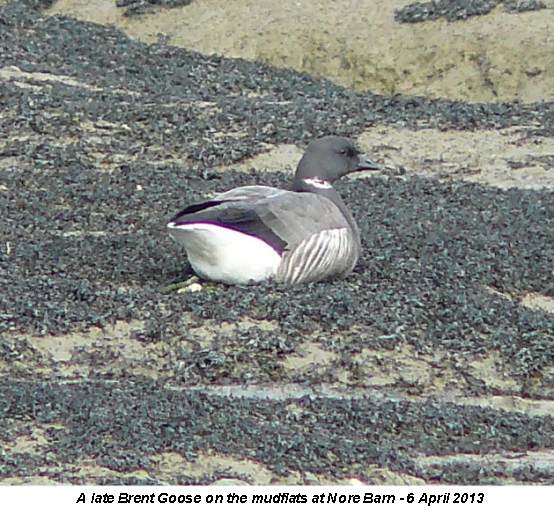
'Pink'
Sweet Violets
The pink Sweet Violets
are still showing well in the western section of Nore
Barn Woods. Ralph Hollins says these are an
intermediate form between the normal violet colour and
the pure pink form.
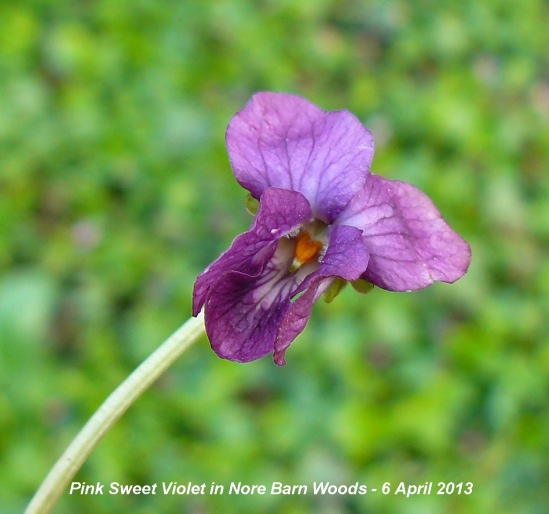
BROOK
MEADOW
Bat
flying
Malcolm Phillips had
an interesting day in the meadow today. He was
surprised to see a bat around in broad daylight; it
was flying round and round the rough ground towards
the Lumley stream and gate, just after 1pm. I don't
know what species it is or how common daytime flying
is in bats. I have asked Nik Knight what he thinks.
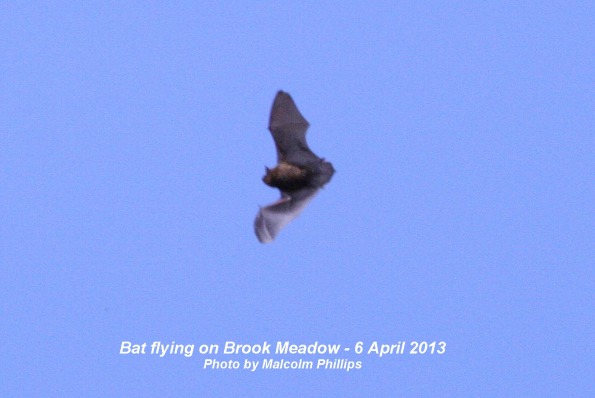
Water
Vole (and Brown Rat)
Malcolm had another
Water Vole sighting on the north bank; it came out a
hole into the water then back in another hole. But
within 30secs a Brown Rat came out of the same hole,
which is not good news. Here is the vole looking
fairly sprightly.
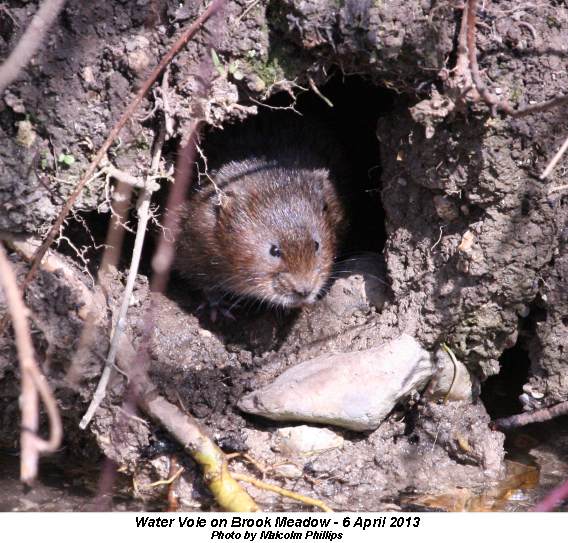
Butterflies
At last we have a bit
of spring sunshine and the butterflies are on the wing
again. Malcolm saw two butterflies, both firsts for
Brook Meadow this year, a Comma and a Small
Tortoiseshell. The latter is particularly welcome
as it has been in severe decline over the past few
years. In fact, we did not get a single sighting last
year on Brook Meadow.
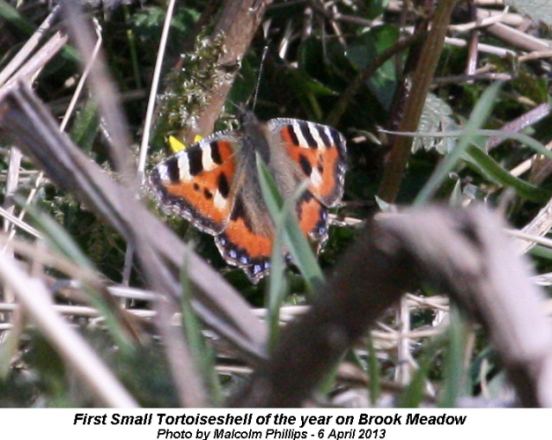
Firecrests
in Havant
Martin Hampton
continues to see and hear the calls, and occasionally
the singing, of a Firecrest in Lower Grove Road in
Havant. Peter Milinets-Raby had previously seen what
is probably the same Firecrest on Mar 23 and Brian
Lawrence also on Mar 30. Yesterday (Apr 5) Martin and
his brother went one step better when they saw a pair
of Firecrests on the Hayling Billy path adjacent to
the road. He is hopeful they may stay to nest as he
thinks happened last year.
FRIDAY
APRIL 5 - 2013
Swallow
or Sand Martin?
Peter Milinets-Raby
queried the photo of a Swallow flying over Peter Pond
in yesterday's blog by Brian Lawrence which he thought
looked more like a Sand Martin. Sand Martin would
certainly fit the observation from the point of view
of timing as they usually arrive and pass through our
area earlier than Swallows. Also, I have often seen
them flying over Peter Pond at this time of the year.
Looking closely at Brian's photo one can see what
Peter is getting at. The bird in the photo lacks the
long tail feathers of a Swallow and the wings look a
bit short for a Swallow. Also, the colouring is
brownish rather like a Sand Martin.
Brian Lawrence agrees
that the bird might well have been a Sand Martin and
sends another image which I think puts the issue
beyond reasonable doubt. It was a Sand Martin.

Water
Voles
Malcolm Phillips went
round the meadow this afternoon and had 3 Water Vole
sightings. The first was at the north bank near the
tunnel at 1pm. The second was just up from the north
bridge at 1.45pm. The third was in front of the
gasholder at 2pm. The one by the north bridge still
has a very bad eye, but comparing it with the last
photo on Mar 28 it seems to be improving. See Graham
Roberts comments on April 2.
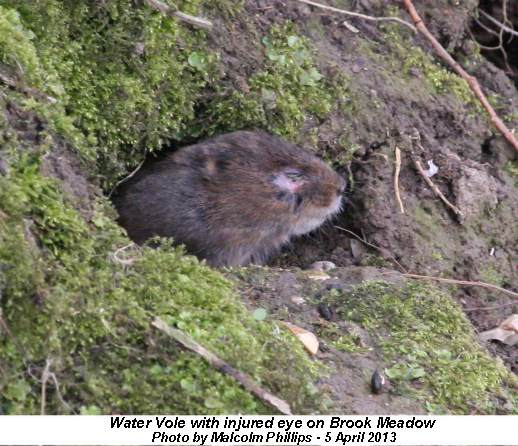
Siskins
in garden
Patrick Murphy had a
pair of Siskins in his Emsworth garden yesterday,
paying a very brief visit. This one looks like a
female as it lacks the black cap and bib of a male.
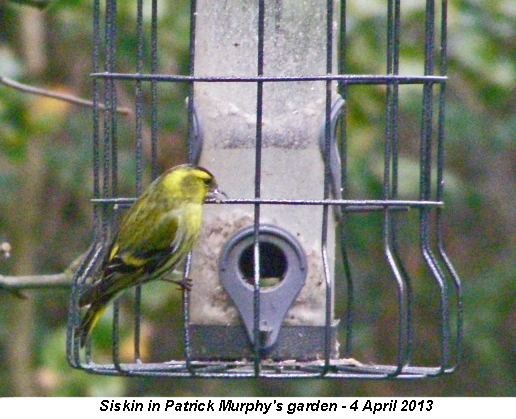
THURSDAY
APRIL 4 - 2013
EMSWORTH
NEWS
Greenshank
with geolocator
A colour-ringed
Greenshank RG+BY was feeding in the low water channel
near the quay at the bottom of South Street at 11am.
This is one of three Greenshanks caught by Pete Potts
and his team at Thorney in March and fitted
geolocators. The other birds fitted with geolocators
are L+WY (which has the geolocator on the W ring) and
RW+BY (with the geolocator on the B ring). I have also
seen RW+BY on the Nore Barn pond on Mar 21.
Greenshank
RG+BY with a geolocator on the blue ring - as a dark
'flag'.

Chiffchaffs
in reeds
I met Brian Lawrence
on the Lumley Path bridge and we watched at least two
Chiffchaffs busily feeding in the narrow channel
between the reeds to the north of Peter Pond. The
birds constantly flew to and fro across the channel,
skimming over the surface of the water as if picking
off insects.
I
managed to get this photo of one of the Chiffchaffs as
it stopped briefly in the reeds.

First
Swallow
Brian has the honour
of recording the first Swallow of 2013 in the present
wildlife blog. He saw one flying over Peter Pond
before he met me and got this fleeting image as it
went by.

Water
Voles
Brian told me he had
seen three Water Voles in the river in the far
north-east corner of the meadow near the railway
tunnel. There were three separate animals which
disappeared into holes in the river bank. This must
mean there is a little colony in this area where we
have had several sightings over the past couple of
months. These take the total number of sightings for
the year so far to 76.
Mute
Swans
The male swan with
dark legs and feet and large knob on its bill was on
Peter Pond and the female with light pink legs and
feet and smaller knob was on Slipper Millpond. But
there appears to be no sign of any nest building.
Greenfinches
return?
I was very pleased to
see 4 Greenfinches back on the sunflower heart feeders
today. The last time I had four was back in October
2012. But gone for good are the days, before the
dreaded trichomonosis outbreak in 2007, when
Greenfinches were my number one garden bird with a
dozen or so regularly clustered on the feeders.
Great
Crested Grebe
John Sawtrell saw what
the first, and probably last, Great Crested Grebe of
the winter on Emsworth Millpond on April 1.

Ring
Ouzel
Also on April 1st,
John Sawtrell saw a Ring Ouzel in a field west of
Warblington Church. Ring Ouzel can be distinguished
from the normal Blackbird by its crescent shaped white
bib, though one needs to be careful since Blackbirds
notoriously sport various white bits on their plumage.
However, John's photo seems to indicate a good male
Ring Ouzel. Thanks to Ralph Hollins for passing this
news and photo onto me.
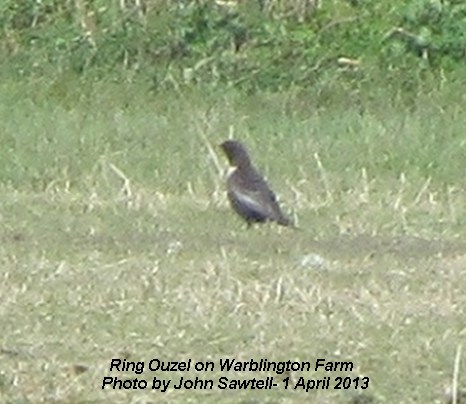
This could have been
the same male bird that was seen by Barry Collins at
Nutbourne Marshes on 31 Mar. Ring Ouzel is a scarce
passage migrant in our area, seen only in spring and
autumn. The Hampshire Bird Report reports 2011 was the
best spring passage of the century with a minimum of
28 birds seen, so it looks as if they are becoming
more common. John should certainly submit the sighting
to the Hants recorder.
WEDNESDAY
APRIL 3 - 2013
EMSWORTH
Brook
Meadow
On this very chilly
morning (the weather seems to be getting colder by the
day), I walked through Brook Meadow. I thought about
doing the annual Butterbur count, but it was much too
cold; also, the spikes are not very big, so I will
wait for a few more days. A Coot had come up from
Peter Pond into the Lumley pool, so I added it to this
year's Brook Meadow bird list, which now stands at 42.
Malcolm Phillips spent
an hour round the meadow today where he saw a Rat on
the bank opposite the deep water sign. Later, a Little
Egret was on the north path and a Wren was doing a
great balancing act.
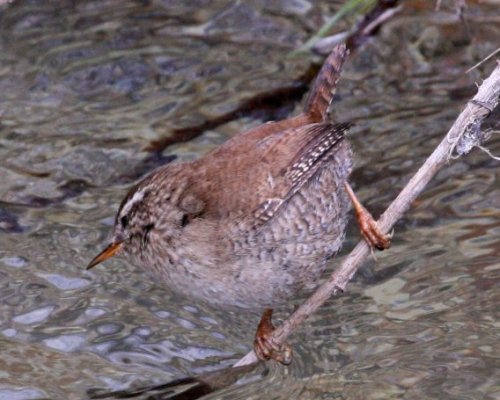
Slipper
Millpond
I had a quick look at
Slipper Millpond where the Coot are back in the nest
box on the south raft, a bit later than usual. The
Great Black-backed Gulls were not there today, but
there were 2 adult Herring Gulls and 6 immature
Herring Gulls. The Polish Mute Swan was swimming near
the Hermitage Bridge, but no sign of its mate or of
any nesting.
Raven
nests
Peter Milinets-Raby
visited Portsdown Hill this morning. He had calculated
that the Ravens should of had young by now. Not quite,
maybe in the next two or three days. But it must be a
bit chilly for them way up there?

Fiona Mckinnon was out
walking on Horndean Down at the weekend and heard the
kronking of a Raven. Looking around she found a pair
nesting on the pylon in the cowfield at the bottom of
the valley, visible from New Barn Farm Lane. Fiona
said they nested in the same place last
year.
Farlington
news
Mike Wells was on
Farlington Marshes yesterday where he saw a group of
about 6 Wheatears, the Red-breasted Goose, (after much
searching), Goldcrest and Skylarks. Mike also watched
a Red Fox which was torn between a pair of Shovelers
on a small pond and a Rabbit behind a bush. He
eventually went for the Rabbit, which was too quick
for him! Mike couldn't resist this lovely wader roost
of Dunlin, Grey Plover and the odd Ringed Plover just
south of the marshes.
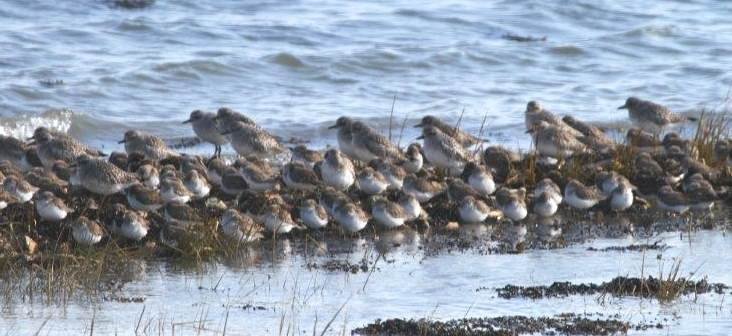
Bob Chapman reported
at least 2,000 Brent Geese were still on the reserve
today along with the long-staying Red-breasted Goose.
Water
Rails
Water Rails are still
prominent around the local area. No more sightings on
Brook Meadow, but Kevin Crisp reported five Water
Rails on Milton Common today and Eric Eddles said two
were still showing well in the wetland areas of
Baffins Pond, one in the south west section and the
other in the southern reed bed.
TUESDAY
APRIL 2 - 2013
Nore
Barn
I did my daily check
of the stream and pond at about 14:30. Tide still
rising. A Common Redshank was feeding in the
low water stream, probably the same bird that Malcolm
Phillips saw here on Mar 31.
A Greenshank
was feeding on the pond at the top of the creek. This
bird is developing its breeding plumage, though in a
less dramatic fashion than the Spotted Redshank.
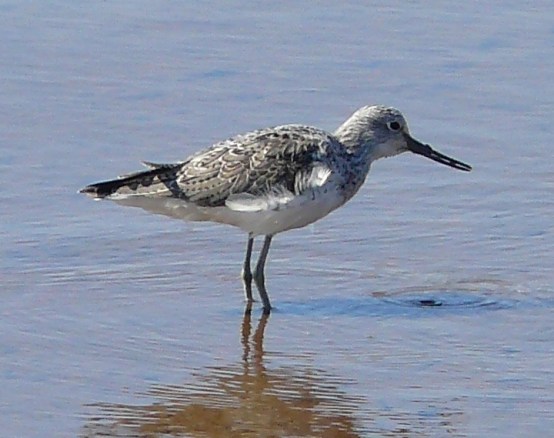
There was no sign of
the dark Spotted Redshank that has also been there for
the past few days. Maybe it has moved off like its
pale companion? However, I shall continue to check for
the next few days.
Brook
Meadow
Maurice Lillie noticed
a new hole had been pecked in the pollarded Willow
beside the north path opposite the railway embankment.
The new hole looking as if it had been drilled by a
machine is almost at the same level as the older one
made about two years ago. Clearly the work of one of
the Great Spotted Woodpeckers that we have in that
area. Not far from this Maurice found a dead Common
Shrew on the path. Wonder what happened to the
poor fellow. A dog maybe?

Woodpigeon
behaviour
Last Wednesday,
Maurice noticed some unusual behaviour by a Wood
Pigeon. It was standing on flat ground close to the
river, west bank just south of the 'S' bend, pecking
the ground. It took off no more than 10cm above the
water and flew at that level, in a vertical posture,
head up and tail down and flicking its tail into the
water as it flew. It landed maybe 6 to 8 metres down
stream, preened its wing and tail briefly then flew up
about a metre onto a branch where it sat and stayed.
Maurice asks, can you explain this? Any offers?
Baffins
Pond
Malcolm Phillips had
to go to Portsmouth today so called in at Baffins Pond
to see the Water Rails and was not disappointed as
they came within 6ft of him. He also saw some splendid
Tufted Duck and Shoveler. I had a feeling Malcolm
would like Baffins.
Have
you ever seen a Water Rail this close before?

Injured
Water Vole
I sent Malcolm's photo
of the Water Vole with an injured eye to Graham
Roberts of the Hampshire Wildlife Trust for his
opinion as to the cause.
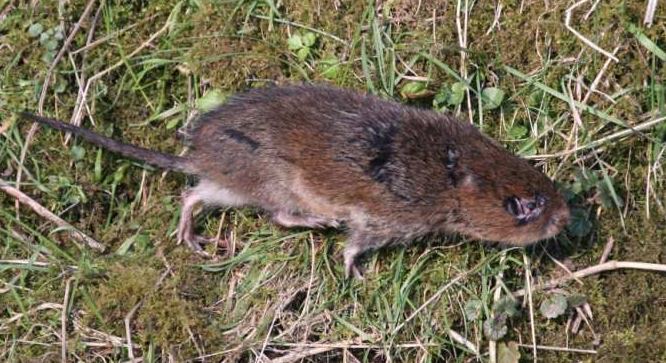
Graham said . . . "
Looking at the picture I definitely would think this a
result of territorial fighting. I have witnessed
similar before and tried to show pity on the
individual and have been bitten in the process - that
did teach me!! Really glad that despite the cold
weather and elevated water levels last year that your
population continues to flourish. Please thank all the
working party followers for their efforts."
Red
Kite
Peter Milinets-Raby
had a Red Kite this morning at 9:50am. It was circling
over Camp Down and seen from Crookhorn Lane (whilst a
pupil was driving).
MONDAY
APRIL 1 - 2013
Spotted
Redshank
I arrived at Nore Barn
at 14:00 about two hours before high water. The stream
was empty of birds. However, as yesterday, the dark
Spotted Redshank (with developing breeding plumage)
was on the pond at the top of the creek feeding with a
unringed Greenshank. Other birds in the creek included
about 30 Brent Geese and a few Wigeon and Teal.
Greenshank
and (dark) Spotted Redshank feeding in the Nore Barn
pond
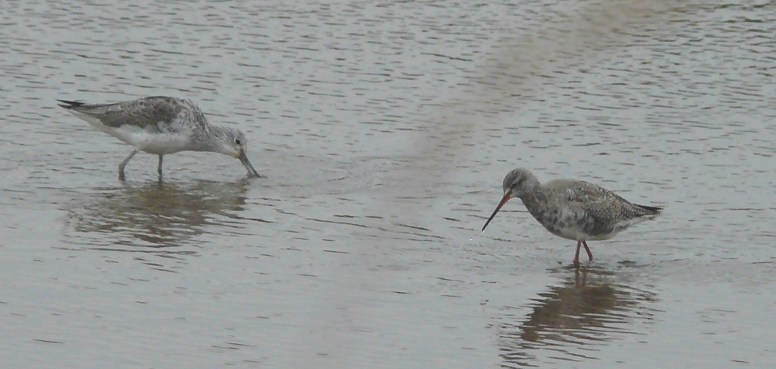
Robin
with food
Malcolm Phillips only
had half an hour round Brook Meadow this morning, but
managed to get a photo of a Robin with a mouthful of
food, hopefully for nestlings.
Robin
collecting juicy insect larvae for nestlings
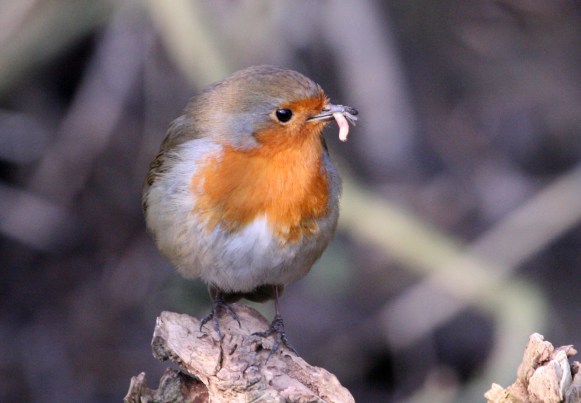
Pheasant
in garden
Patrick Murphy had a
surprise visitor to his garden today in the form of a
handsome cock Pheasant which spent about an hour in
the garden, mainly feeding fallen seed from the
feeders.
Handsome
cock Pheasant in Patrick's garden
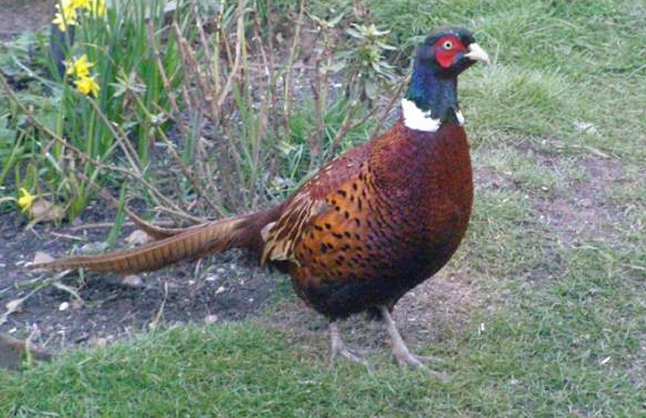
Blackcap
migrant query
Patrick also had a
female Blackcap on the fatballs a couple of days ago
and asked if this could be a summer migrant? It could
be, but one can never be too sure at this time of the
year when there is an overlap between the population
that have been wintering here and those newly arriving
from the south. My rule of thumb is that Blackcaps
seen on garden feeders at this time of the year are
wintering birds, fattening up for their journey back
to the Continent. I suppose they will not be in a
hurry to move off until the current easterly winds
abate. I expect to see and hear the summer migrant
Blackcaps in their traditional breeding habitats, like
Brook Meadow or Hollybank Woods.
Migrants
arriving early
Ralph Hollins has
provided another table of migrant arrival dates to
justify his claim (which surprised me at least) that
this is an 'earlier than average' year for migrants
"even if they do die of starvation on arrival" (Ralph
adds). See his daily diary for Sat 30 Mar . . .
http://ralph-hollins.net/Diary.htm
For
earlier observations go to . . March
16-31